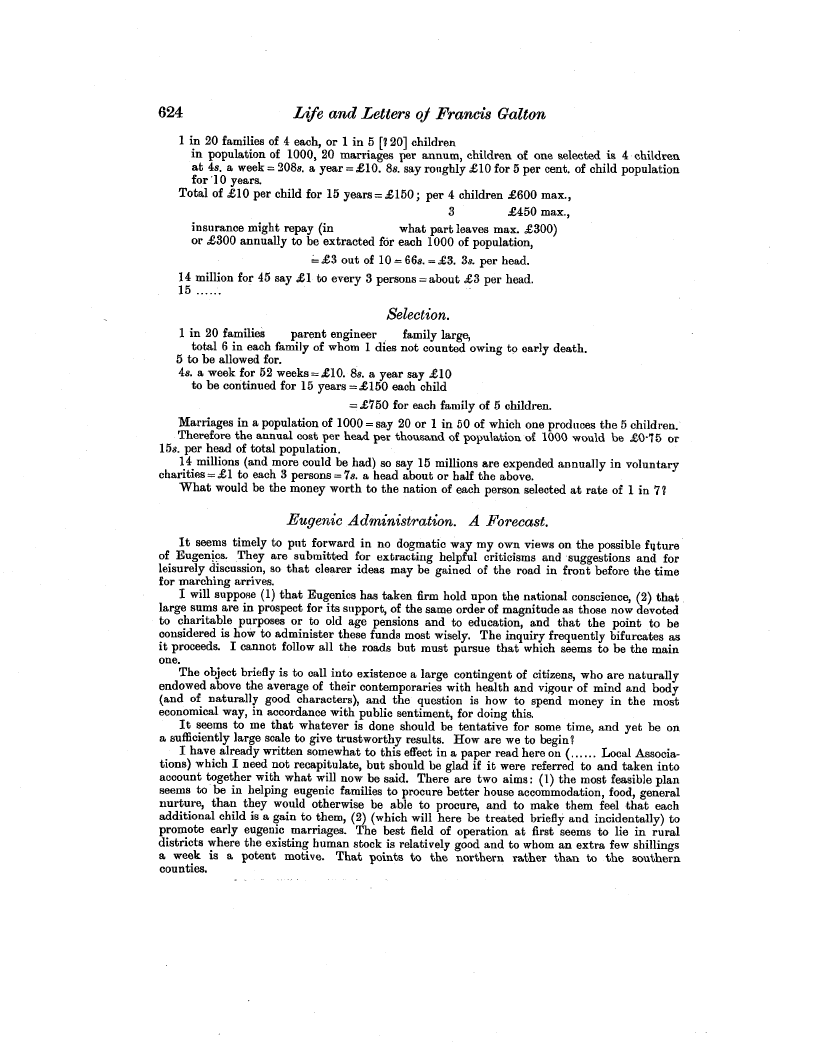| ||||||

OCR Rendition - approximate
624 Life and Letters of Francis Galton 1 in 20 families of 4 each, or 1 in 5 [? 20] children in population of 1000, 20 marriages per annum, children of one selected is 4 children at 4s. a week = 208s. a year =£10. 8s. say roughly £10 for 5 per cent, of child population for "10 years. Total of £10 per child for 15 years= X150; per 4 children £600 max., 3 £450 max., insurance might repay (in what part leaves max. £300) or £300 annually to be extracted for each 1000 of population, £3 out of 10 = 66s. = £3. 3s. per head. 14 million for 45 say £1 to every 3 persons= about £3 per head. 15 Selection. 1 in 20 families parent engineer . family large, total 6 in each family of whom 1 dies not counted owing to early death. 5 to be allowed for. 4s. a week for 52 weeks=£10. 8s. a year say £10 to be continued for 15 years =£150 each child =£750 for each family of 5 children. Marriages in a population of 1000 = say 20 or 1 in 50 of which one produces the 5 children. Therefore the annual cost per head per thousand of population of 1000 would be £O-75 or 15s. per head of total population. 14 millions (and more could be had) so say 15 millions are expended annually in voluntary charities= £ 1 to each 3 persons= 7s. a head about or half the above. What would be the money worth to the nation of each person selected at rate of 1 in 7? Eugenic Administration. A Forecast. It seems timely to put forward in no dogmatic way my own views on the possible future of Eugenics. They are submitted for extracting helpful criticisms and suggestions and for leisurely discussion, so that clearer ideas may be gained of the road in front before the time for marching arrives. I will suppose (1) that Eugenics has taken firm hold upon the national conscience, (2) that. large sums are in prospect for its support, of the same order of magnitude as those now devoted to charitable purposes or to old age pensions and to education, and that the point to be considered is how to administer these funds most wisely. The inquiry frequently bifurcates as it proceeds. I cannot follow all the roads but must pursue that which seems to be the main one. The object briefly is to call into existence a large contingent of citizens, who are naturally endowed above the average of their contemporaries with health and vigour of mind and body (and of naturally good characters), and the question is how to spend money in the most economical way, in accordance with public sentiment, for doing this. It seems to me that whatever is done should be tentative for some time, and yet be on a sufficiently large scale to give trustworthy results. How are we to begin? I have already written somewhat to this effect in a paper read here on ( Local Associations) which I need not recapitulate, but should be glad if it were referred to and taken into account together with what will now be said. There are two aims: (1) the most feasible plan seems to be in helping eugenic families to procure better house accommodation, food, general nurture, than they would otherwise be able to procure, and to make them feel that each additional child is a gain to them, (2) (which will here be treated briefly and incidentally) to promote early eugenic marriages. The best field of operation at first seems to lie in rural districts where the existing human stock is relatively good and to whom an extra few shillings a week is a potent motive. That points to the northern rather than to the southern counties.
|